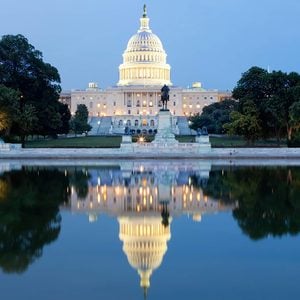20 States Where Women Could Vote Before 1920
Updated: Mar. 13, 2023
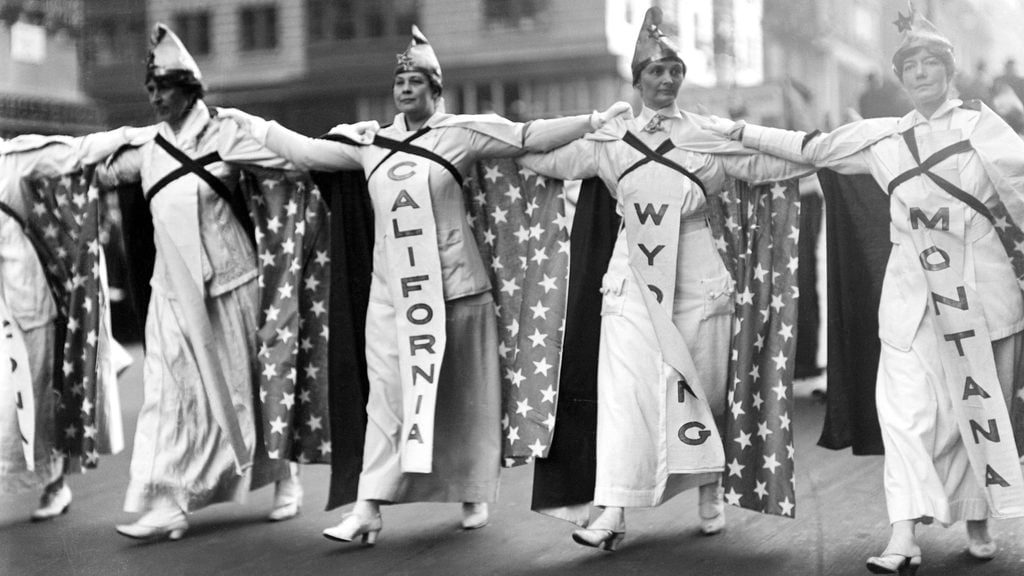
This year marks the 100th anniversary of the 19th Amendment, which guaranteed American women the right to vote. But women living in these states and territories achieved suffrage long before it went national.
States with early suffrage
One century ago, American women won the constitutional right to vote when the 19th Amendment was passed. But some states and territories were way ahead of the nation, granting women suffrage up to 50 years earlier. As of January 1920—just months before the 19th Amendment was ratified—women living in these 20 states and territories were already casting their ballots in local, state, and federal elections. Later that year, the 19th Amendment would ultimately be adopted thanks in part to a young Tennessee legislator with a very persuasive mother.
Wyoming
Western U.S. territories like Wyoming were trailblazers for the women’s suffrage movement in America. In 1869, Wyoming legislator William Bright introduced a bill granting women the right to vote and run for public office. The bill was passed and signed into law with little protest in December 1869, more than 50 years before the 19th Amendment was adopted. Wyoming later earned the nickname “Equality State” for being the first to protect women’s right to vote. The next fall, 69-year-old Louisa Swain made history as the first woman in the United States to cast a ballot in a national election. It turned out to be one of the 13 moments that changed women’s history forever.
Utah
Following in Wyoming’s footsteps, the Utah Territory legalized women’s right to vote in 1870. Utah’s large Mormon community and anti-Mormon lawmakers formed an unusual alliance to pass suffrage. They supported it for different reasons: While local politicians against Mormonism believed that allowing women to vote would end the Mormon practice of polygamy, many Mormon men believed that it would make polygamy more acceptable. In 1896, Dr. Martha Hughes Cannon—herself the fourth wife in a polygamous Mormon marriage—became the first female state senator in the country, defeating her own husband, who also ran for the office. These 15 countries gave women the right to vote before the United States did, too.
Colorado
The newly formed state of Colorado held a popular referendum on women’s suffrage in 1876, but it was narrowly defeated due to voters’ concerns that women would vote for a ban on alcohol sales. For more than a decade, suffragists continued to fight for women’s voting rights by forming organizations such as the Colorado Non-Partisan Equal Suffrage Association, sending pro-suffrage speakers across the state, and writing articles in local newspapers. Their tireless campaign managed to change a lot of minds. In 1893, Colorado became the first state to pass women’s suffrage by referendum. Like the suffragists before them, these inspiring women are changing the lives of women across the world today.
Idaho
Booze played an important role in the successful fight for women’s voting rights in Idaho, according to Katherine G. Aiken, a history professor at the University of Idaho. Prohibitionists hoped that allowing women to vote would help to enact a statewide liquor ban, and as a result, the majority of the state voted for suffrage in 1896. Another fun fact: Idaho was the first state to elect a female delegate to attend a national convention. When Susie M. West of Lewiston, Idaho arrived at the National Republican Convention at Chicago in 1904, her presence reportedly “caused quite a stir” among the male delegates. Learn about 57 other trailblazing females who made history.
Washington
Get this: Washington would have been the first state in the country to grant women’s suffrage, but the bill was defeated by a single lawmaker’s vote in 1854. The Washington Woman Suffrage Association, formed with help from famous suffragist leaders like Susan B. Anthony, eventually won voting rights for Washington women in 1883. However, the territory’s Supreme Court overturned the law twice when liquor businesses protested it. After Washington became a state, the legislature finally amended its constitution to grant women the right to vote in 1910. Check out these rarely seen photos of the first female voters when the 19th Amendment was passed a decade later.
California
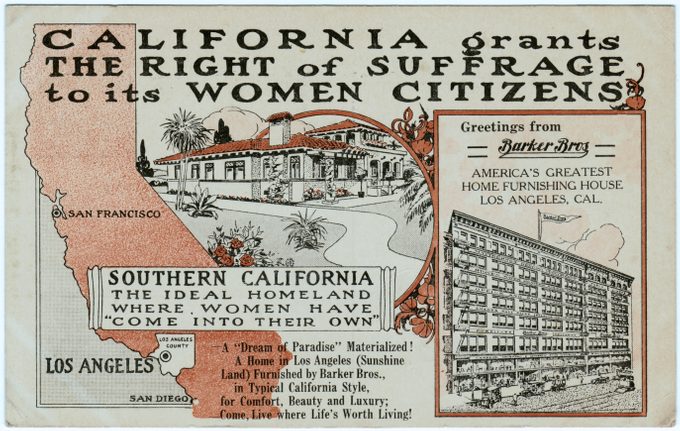
Elizabeth Thacher Kent, who owned part of California’s iconic redwood forests, was one of the most influential women in the state’s suffrage movement. Rather than hosting the social events that were popular among the day’s suffragists, Kent encouraged women to give speeches, hold rallies, and register voters in order to win the vote. Her efforts soon paid off: In 1911, the people of California voted in favor of women’s suffrage in a statewide referendum. Sixty years later, March Fong Eu became the first Asian Pacific Islander to hold a statewide executive office when she was elected California’s Secretary of State. Bet you didn’t learn about these 9 inspiring women in history class, either.
Oregon
Inspired by Susan B. Anthony’s tour of the Pacific Northwest to boost support for suffrage, women in Oregon launched the Oregon Woman Suffrage Association in 1871. The organization successfully placed a constitutional amendment for women’s voting rights on Oregon’s ballot six times, but it wasn’t until 1912 that a majority of men voted to recognize women’s right to vote. Longtime suffragist Abigail Scott Duniway, known as Oregon’s “Mother of Equal Suffrage,” was 78 years old when the amendment finally passed. That year, she authored and signed Oregon’s Equal Suffrage Proclamation, guaranteeing Oregonian women’s voting rights. She’s just one of the lesser-known women pioneers who changed the world.
Montana
Montana native Jeannette Rankin was at the forefront of the state’s fight for suffrage, successfully campaigning for a state constitutional amendment to grant suffrage in 1914. Two years later, Montana voters elected Rankin to represent them in the U.S. House of Representatives, making her the first woman to be elected to national office and the first female member of Congress. Soon after she was sworn in, Rankin introduced the Susan B. Anthony Woman Suffrage Amendment, which eventually became the 19th Amendment. “I may be the first woman member of Congress,” she said after being elected. “But I won’t be the last.” That turned out to be true, unlike these historical predictions that missed the mark.
Arizona
As the Arizona Territory was applying to become a U.S. state in 1891, suffragists were fighting for women’s voting rights to be included in Arizona’s future state constitution. However, hope for constitutional protection for women’s suffrage fizzled out when U.S. President Harrison denied the territory’s bid for statehood. Arizona became a state on February 14, 1912, and the Arizona male electorate voted to enfranchise women the following November. In 1963, Justice Lorna Lockwood became the first woman elected to the Arizona Supreme Court and the first woman in the United States to serve as chief justice of a state supreme court.
Kansas
Although women in Kansas could vote in local elections starting in 1887, only men could cast ballots for the president and Congress. Over the following decades, white and black suffragists formed a unique partnership to promote women’s suffrage in the state, and Kansas women eventually won universal voting rights in 1912. In the first year that Kansas women could vote in local elections, voters elected Susanna Salter to serve as the mayor of Argonia and the nation’s first female mayor. Believe it or not, she didn’t learn that her name was on the ballot until the morning of the election.
Alaska
Alaska never officially voted on the 19th Amendment in 1920 because it wasn’t a state at the time. But white women in the Alaska territory were already casting their ballots seven years earlier, thanks in part to Lena Morrow Lewis, who raised awareness for suffrage during her 1912 campaign for state delegate. Two years after passing women’s suffrage, Alaska’s legislature also recognized the right of Indigenous men and women to vote. Alaskan women continue to make history to this day. Former Governor Sarah Palin became the first woman on a national GOP ticket when she joined Senator John McCain’s 2008 campaign as his vice-presidential running mate.
Illinois
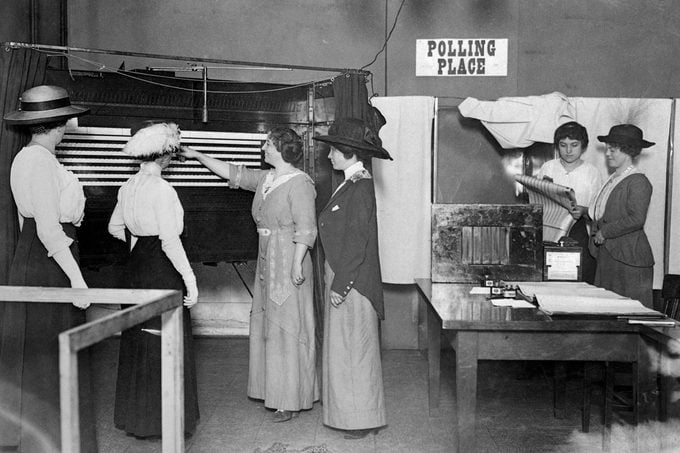
Efforts by Illinois suffragists such as Grace Wilbur Trout and Jane Addams paved the way for yet another groundbreaking moment in the national suffrage movement. In 1913, the legislature passed a law granting women in Illinois the right to vote in presidential and municipal elections. By doing so, Illinois became the first state east of the Mississippi where women could vote. Illinois also came close to being the first state to ratify the 19th Amendment. The state legislature approved ratification on June 10, 1919, but an administrative error forced them to redo the vote a week later, technically making Wisconsin—which also voted on June 10—the first state to ratify the 19th Amendment.
North Dakota
Women living in the Dakota Territory won the right to vote in school elections in 1883. However, legislation that would have allowed women to vote in all elections was defeated by one vote in 1875, and a similar bill was vetoed by the governor in 1885. Yet another bill passed the legislature in 1914 but was voted down by the public. Finally, in 1917, state legislators approved a law that gave women the right to vote for president and some municipal positions. To promote the cause of her fellow North Dakotan suffragists, mountaineer Dr. Cora Smith Eaton placed a banner that read “Votes for Women” near the summit of Washington’s Mount Rainier in 1909.
Indiana
In 1859, three Indiana suffragists submitted the first petition advocating for women’s right to vote to the state legislature. But the movement stalled for decades due to the difficulty of amending the state constitution, which required at least two years to be approved. Over the next 50 years, suffragists also faced many other setbacks. Laws allowing women to vote were defeated, overturned by the state’s courts, or even erased from the books. At long last, in 1917, the Indiana General Assembly passed a law granting Indiana women the right to vote in presidential, municipal, and some state elections.
Nebraska
Nebraskan suffragists’ attempts to change the state’s constitution to protect women’s voting rights were defeated multiple times by the state’s male voters. The 1916 election of pro-suffrage Governor Keith Neville, however, became a turning point for the movement. Thanks to his support, partial suffrage for women became law in 1917. Although anti-suffrage organizations tried to overturn the law, their effort failed when some signatures on their petition turned out to be forged. Seventy years later, Nebraska Governor Kay Orr became the first Republican woman in the United States to be elected governor of a state. Read these 20 quotes from amazing women in history for a confidence boost.
Michigan
As early as 1855, Michigan women were petitioning the legislature for suffrage. They achieved the right to vote in school board elections after the Civil War. Despite multiple failed attempts to pass state constitutional amendments and ballot initiatives for universal suffrage, the women of Michigan were finally given the right to vote in all elections in 1918. Just five years after the 19th Amendment was added to the U.S. Constitution, Cora Reynolds Anderson became the first woman elected to the Michigan House of Representatives and the first Native American woman to serve in a state legislature. Check out more empowering stories of women you didn’t learn about in history class.
Arkansas
Many Southern states were much slower than states in the East and West to grant women’s voting rights. But in 1917, Arkansas surprised suffragists across the nation by passing legislation making women eligible to vote in primary elections. Over 40,000 women voted in the statewide primaries the next year, electing over 50 female delegates to the Democratic State Convention. In another milestone for suffragists, Hattie Wyatt Caraway of Arkansas became the first woman in the country elected to serve in the U.S. Senate in 1932. She was appointed to finish the term of her late husband, Senator Thaddeus Caraway, then won re-election the following year and served for a total of 14 years.
New York
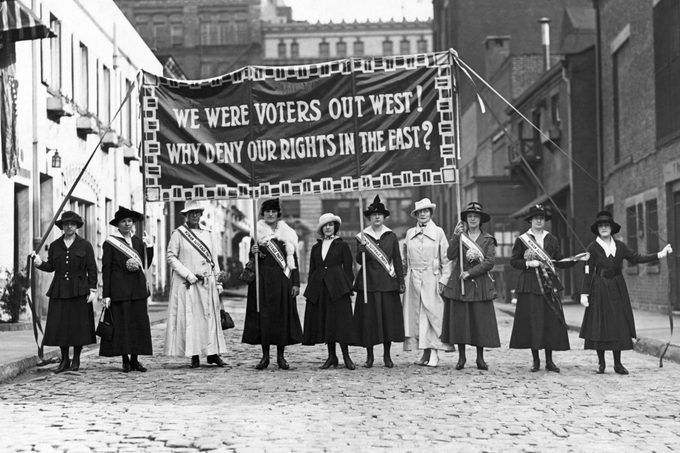
New York is widely considered the birthplace of women’s suffrage in America. Not only was it the location of the nation’s first women’s rights convention, which launched the nationwide suffrage movement, but native New Yorker Susan B. Anthony was also one of the movement’s most prominent leaders. After several defeats, New York women finally won the constitutional right to vote in November 1917. Long before women in New York could cast their ballots, however, local suffragist Elizabeth Cady Stanton was the first-ever woman to run for the U.S. House of Representatives, receiving 24 out of 12,000 votes. You probably didn’t know these facts about Susan B. Anthony, either.
South Dakota
Like many state constitutions at the time, the language in South Dakota’s state constitution only recognized the right of men to vote. Four different amendments extending voting rights to women were introduced starting in 1890, but each was defeated. In 1918, another state constitutional amendment called the Citizenship Amendment removed the word “male” from the state constitution’s language, granting voting rights to all residents. The amendment passed the South Dakota legislature and was approved by voters in November 1918. Exactly 100 years and one day after women’s suffrage passed in South Dakota, Republican Kristi Noem was sworn in as South Dakota’s first female governor.
Oklahoma
The women’s suffrage movement was born in the Territory of Oklahoma with the formation of the Woman’s Christian Temperance Union (WCTU) in 1890. Supporters of prohibition hoped that making women eligible to vote would help their cause. When Oklahoma became a state 17 years later, its new constitution guaranteed women the right to vote in school elections, but not state or federal ones. Oklahoma residents voted overwhelmingly for a state constitutional amendment granting full women’s suffrage in 1918. When Lelia Foley-Davis was elected mayor of Taft, Oklahoma in 1973, she became the nation’s first elected black woman mayor.


